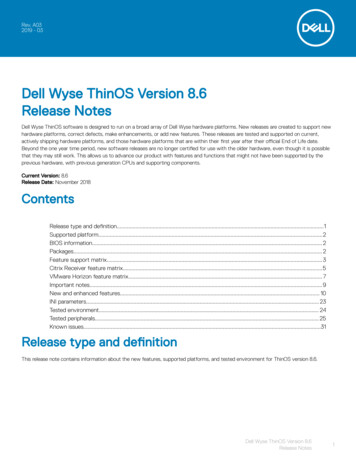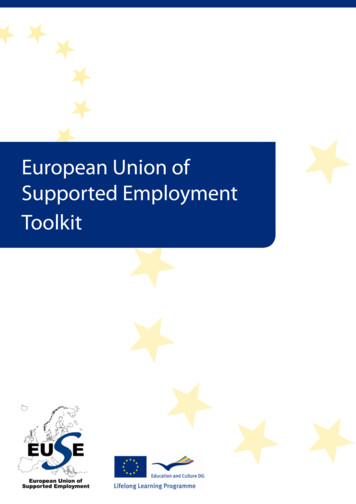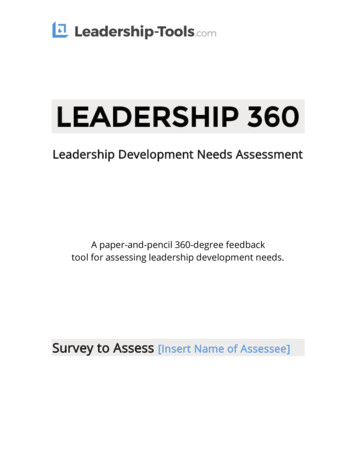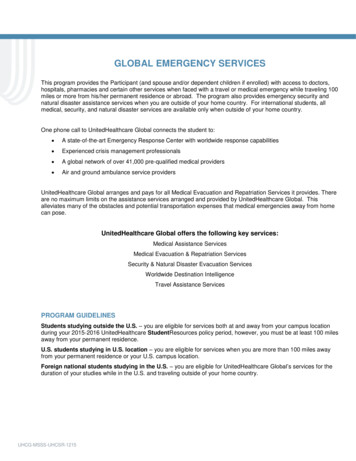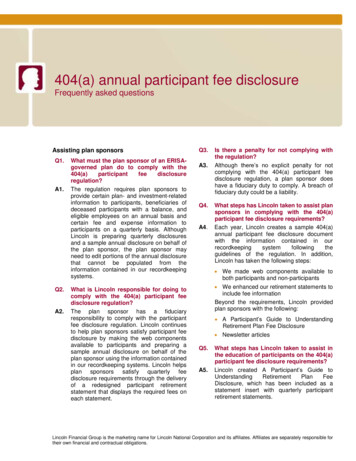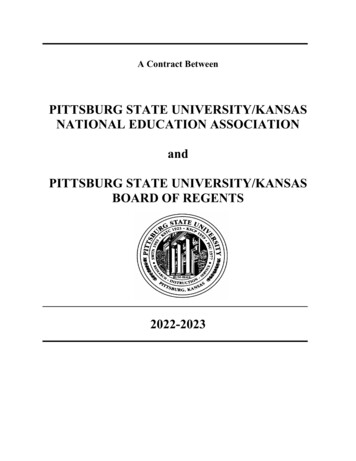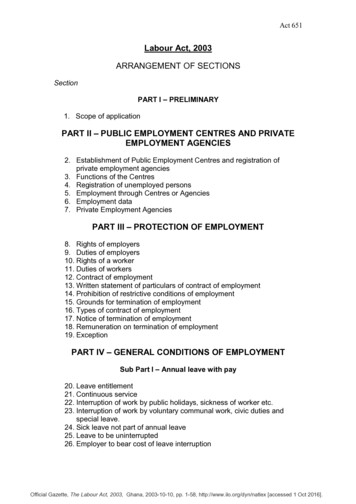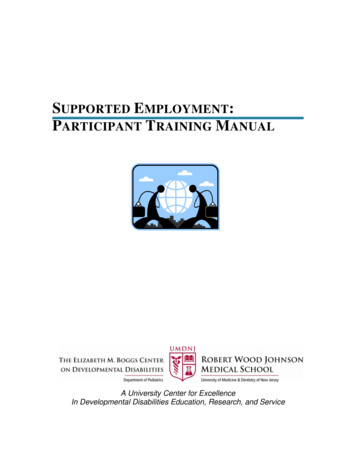
Transcription
SUPPORTED EMPLOYMENT:PARTICIPANT TRAINING MANUALA University Center for ExcellenceIn Developmental Disabilities Education, Research, and Service
Supported EmploymentParticipant Training ManualThis training manual was produced by the Elizabeth M. Boggs Center onDevelopmental Disabilities and funded by the state of New Jersey,Department of Human Services, Division of Developmental Disabilities.Contract 09ML5C.Any section or segment of this workbook may be reproduced or adaptedusing appropriate acknowledgement and citations.Suggested citation:Camuso, A., and Baker, D. (2008). Supported Employment: ParticipantTraining Manual. New Brunswick, NJ: The Elizabeth M. Boggs Center onDevelopmental Disabilities, University of Medicine and Dentistry of NewJersey-Robert Wood Johnson Medical School.2008 The Elizabeth M. Boggs Center on Developmental Disabilities.335 George StreetP.O. Box 2688New Brunswick, NJ 08903-2688Phone: (732) 235-9300Fax: (732) 235-9330Website: http://rwjms.umdnj.edu/boggscenterAnthony R .Camuso Jr., B.A.Dan Baker, Ph.D.
Supported Employment: Participant Training ManualAbout The Elizabeth M. Boggs Centeron Developmental DisabilitiesThe Elizabeth M. Boggs Center on Developmental Disabilities is NewJersey’s federally designated University Center for Excellence inDevelopmental Disabilities Education, Research, and Service (UCEDD).The Boggs Center is part of the University of Medicine and Dentistry ofNew Jersey (UMDNJ) – Robert Wood Johnson Medical School, Departmentof Pediatrics. Since its inception in 1983, The Center has emphasized acommunity based, life span approach to meeting the needs of individualswith developmental disabilities and their familiesThe Boggs Center provides community and student training and technicalassistance, conducts research and model demonstrations, and disseminatesinformation and educational materials. Its activities of are guided by itsConsumer Advisory Council and partnerships with people with disabilities,families, state and community agencies, and policy makers.The Boggs Center is part of a national network of federally designatedUniversity Centers for Excellence in Developmental Disabilities Education,Research, and Service. The purpose of University Centers, as outlined in thefederal Developmental Disabilities Assistance and Bill of Rights Act, is towork with their “sister” organizations in each state’s Administration onDevelopmental Disabilities Network – the Councils on DevelopmentalDisabilities and Protection and Advocacy – to provide leadership in thepromotion of independence, productivity, and the full inclusion of peoplewith developmental disabilities in all facets of community life.To learn more about The Elizabeth M. Boggs Center on DevelopmentalDisabilities, including current projects, upcoming events, and professionaltraining opportunities, please visit our website at:http://rwjms.umdnj.edu/boggscenterThe Elizabeth M. Boggs Center on Developmental Disabilitiesi.
Supported Employment: Participant Training ManualPrimary AuthorAnthony R. Camuso is a Training and Consultation Specialist at TheElizabeth M. Boggs Center on Developmental Disabilities. He providesSupported Employment and Direct Support Workforce Developmenttraining and technical assistance. He has worked in a variety of directsupport and management roles including supported employment,residential, and transition services. Anthony has presented at both nationaland state conferences including National APSE: The Network onEmployment, NJ Association for Persons in Supported Employment, TheAmerican Association on Intellectual and Developmental Disabilities, TheNational Caregiver’s Conference, The NJ Association of CommunityProviders, and The NY Metro Abilities Expo.Co-Author & EditorDan Baker, Ph.D., is an Assistant Professor at The Elizabeth M. BoggsCenter on Developmental Disabilities, UMDNJ-Robert Wood JohnsonMedical School, Department of Pediatrics. Dr. Baker's areas of interest andexpertise include Positive Behavior Support, mental health for persons withIntellectual or Developmental Disabilities, special education, supportedemployment, and workforce development. He has authored book chapterson positive behavior support and is currently the Co-editor of The NADDBulletin. Dr. Baker holds a Ph.D. in Educational Psychology from theUniversity of Minnesota and is a Fellow of AAIDD.Copy EditorRobyn E. Carroll, MSW, Communications Manager, The Elizabeth M. BoggsCenter on Developmental Disabilities, UMDNJ-Robert Wood Johnson MedicalSchool, Department of Pediatrics.External EditorA special thanks to Roger Stanton for providing invaluable editorialcontributions.The Elizabeth M. Boggs Center on Developmental Disabilitiesii.
Table of ContentsSection 1:Fundamental Principles of Supported Employment1-271.1.Introduction .1-51.2.Core Values & Guiding Principles .5-61.3.Self-Determination .7-141.4.Informed Choice 15-181.5.Person First Language .19-24Section 2:The Growth & Development of Supported Employment28-442.1.Concept of Supported Employment .28-292.2.Models of Supported Employment .30-312.3.Facility-Based Employment & Community-Based Employment.32-362.4.Facility-Based Programs: What Do the Numbers Say?.37-41Section 3:Working for All the Right Reasons45-573.1.Road to Employment Success.45-473.2.Why Do People Work?.48-503.3.Why Do People Not Work?.51-523.4.Employment for People with Disabilities.52-533.5.New Jersey: People with Disabilities in the Garden State.54-55Section 4:Roles, Responsibilities & Expectations58-1274.1Job Seeker.64-654.2Employment Specialist.66-694.3Supported Employment Agency.70-754.4New Jersey Funding Agencies.76-784.5Family & Friends.794.6Employer.80Section Appendices:A: DDD 2007 SE Standards Manual.83-114B: APSE Quality Indicators.115-119C: APSE Ethical Guidelines.120-122D: APSE Competencies.123-127The Elizabeth M. Boggs Center on Developmental Disabilitiesiii.
Table of ContentsSection 5:Career Planning & Assessment128-1545.1Assessment Basics.128-1305.2Getting to Know the Person.131-1335.3Methods of Assessment.134-1385.4Putting it All Together.139-1425.5Beyond Jobs: Developing a Career Path.143-146Section Appendices:A: The 16 Career Clusters.149-151B: Transferable Skills Checklist.152-154Section 6:Supported Employment & Marketing155-1846.1Marketing Basics.155-1696.2Avoiding Marketing Mistakes.169-1726.3Customer-Focused Marketing.173-1756.4Getting to Know Your Customer.176-1786.5Marketing Code of Ethics.179-182Section 7:Job Development185-2807.1Job Development: Where to Begin.185-1937.2Networking: Connecting with Employers.194-2037.3Engaging the Employer: What to Say, and How andWhen to Say it?.204-2197.4Job Analysis: Assessment of the Worksite.2207.5Dispelling Disability Myths & Misconceptions.221-2227.6Job Hunting for the 21st Century: The Role of the Internet.223-2257.7Americans with Disabilities Act & Employment:What You Need to Know.226-233Section Appendices:A: Reasonable Accommodations: Situations & Solutions.238-251B: Customized Employment.252-280The Elizabeth M. Boggs Center on Developmental Disabilitiesiv.
Table of ContentsSection 8:Job Training Strategies & Workplace Supports281-3288.1Successful Job Coaching.281-2868.2Developing Workplace Natural Supports.286-2888.3Teaching Self-Management Skills.289-2908.4Assistive Technology.290-2928.5Using Direct Instruction to Teach Job Skills.293-2948.6Systematic Instruction & Task Analysis.295-2988.7Challenging Behaviors in the Workplace.299-3038.8Positive Behavior Support.303-3048.9Developing a Fading & Ongoing Support Plan.305-3078.10Effective Record Keeping & Documentation.308-312Section Appendices:A: Case Studies.314-322B: Supports Needs Data Form.323-328Section 9:How Did We Get Here: A Brief Look Back329-3449.1.Setting the Stage for Supported Employment.329-3329.2.Rehabilitation Act of 1973.333-3359.3.Americans with Disabilities Act of 1990.335-3379.4.Presumption of Eligibility.337-3399.5.Supported Employment Timeline.340-341Section 10:Federal Work Incentive Programs for People with Disabilities345-36810.1. Overview of Business Tax Incentive Programs.345-34610.2. Work Opportunity Tax Credit (WOTC).347-34810.3. Small Business Tax Credit.34910.4. Architectural & Transportation Tax Deduction.350-35110.5. Social Security Disability Programs.352-357Section Appendices:A: IRS Form 8850.359-365B :IRS Form 8826.366-368The Elizabeth M. Boggs Center on Developmental Disabilitiesv.
Table of ContentsManual References & Resources369-384Manual Resources.369-375Manual References.376-383The Elizabeth M. Boggs Center on Developmental Disabilitiesvi.
Section 1FUNDAMENTAL PRINCIPLES OFSUPPORTED EMPLOYMENT
Section 1: Fundamental Principles of Supported EmploymentSection 1:Fundamental Principles of Supported Employment1.1Introduction1.2Core Values & Guiding Principles1.3Self-Determination1.4Informed Choice1.5Person First LanguageParticipant Learning ObjectivesAt the conclusion of this section, you will be able to: Discuss the five principles of Self-Determination. Explain the significance of self-determined employmentservices. Define at least five supported employment core values. Identify the essential aspects of informed choice. Describe the concept of informed consent at it pertains toemployment services for people with disabilities. Summarize the key laws and regulations that led toinclusive, self-directed services and supports for peoplewith disabilities. Discuss the significance of respectful and person firstlanguage when interacting with and referring to peoplewith disabilities.The Elizabeth M. Boggs Center on Developmental Disabilities1
Section 1: Fundamental Principles of Supported Employment1.1 Introduction: The Purpose of this WorkbookWhat is the purpose of this workbook?This workbook will help you develop the necessary skills and abilities neededto provide effective employment supports for people with disabilities. Readerscan expect to benefit from this workbook in the following ways: It will offer you basic knowledge and understanding of qualityemployment supports while also introducing you to more advancedconcepts and principles. It will provide practical strategies and step-by-step illustrations forimplementing the many proven approaches and empirical based practicesthat are presented. It will give you numerous examples, suggested activities, and sampleexercises to facilitate and reinforce learning.How is this workbook designed?This workbook will take readers through the most probable progression ofemployment supports. It is comprised of ten separate sections that addressnumerous key supported employment concepts. It begins by examining thebasic premise of work itself by asking the simple yet profound question,“Why do people work?” From this point, we explore the current state ofemployment for people with disabilities followed by a closer look at theoverall development, growth, and current direction of supported employment.Additional core concepts covered in the ten sections of this workbook include: Person First Language Roles & Responsibilities of Primary Stakeholders Career Planning & Assessment Job Development Job Training Workplace SupportsThe Elizabeth M. Boggs Center on Developmental Disabilities2
Section 1: Fundamental Principles of Supported EmploymentMany training manuals begin with an in depth historicalperspective about the subject matter. This manual will insteadstart by introducing the core values and driving principles thatform the foundation of supported employment; however, historians neednot be alarmed. We have not forgotten about this most importantsubject. Section 9 provides a detailed supported employment historicaltimeline including significant events that helped develop and shapeemployment services for people with disabilities.While each section explores different subjects and topics, they allreflect the same fundamental and philosophical values that form thefoundation of this workbook including the following: Given the proper supports, work environment, and the desire to work,all people with disabilities are employable. The primary goal of supported employment services is to helpindividuals find employment that offers competitive wages in typicalwork settings regardless of disability. Informed individual choice, self-determination, and person centeredservices form the foundation of all professional supports. Individuals strengths, abilities, preferences, and interests help to guidethe job search and ultimate work selection. The development of a career path that includes future planning, skillbuilding, and ongoing career exploration, which facilitates theprogression from entry-level positions to higher levels of pay, skill,responsibility, or authority.The Elizabeth M. Boggs Center on Developmental Disabilities3
Section 1: Fundamental Principles of Supported EmploymentHow should this workbook be used?This workbook will provide practical principles, strategies, and guidance toprofessionals providing supported employment services. It can be used as atraining reference, professional resource, or as an agency instructional manual.When used as a reference, it can help staff develop, rediscover or reinforce jobskills that are critical toward helping people achieve their work goals andobjectives. For the purpose of this workbook, the term employment specialistrefers to supported employment direct support staff. This refers to staff that doboth job development, such as conducting individual assessments and contactingemployers to develop employment opportunities; and job coaches, whichincludes training and supporting individuals at their job sites. Some of theessential job skills for employment specialists covered in this workbook include: Facilitating Initial Career PlanningIdentifying Job Skills and Work InterestsFinding & Approaching EmployersUnderstanding Confidentiality and Disability DisclosureDetermining the Best Possible Job MatchIdentifying the Most Effective Workplace SupportsSome users may find it helpful to read each section beginning with the firstsection and completing any suggested activities along the way. Others mayfind it more beneficial to read those sections or specific topics that are ofmost interest or relevance to their job. Additional content includes suggestedreadings, useful internet resources including state, federal and nationallyrecognized organizations and helpful forms to use in the field and at worksites.Lastly, we encourage professionals to use this workbook with an open mind.The various strategies, principles, suggested activities, and case studies are notrepresentative of all people with disabilities, types of disabilities, or situationsthat one may encounter on the job. However, this manual is written based onthe fundamental philosophy that people with disabilities can and should work.The core values and guiding principles discussed throughout this workbookapply to supporting all people with disabilities. It is a thorough and practicalguide intended to help professionals assist people with disabilities inachieving their employment goals.The Elizabeth M. Boggs Center on Developmental Disabilities4
Section 1: Fundamental Principles of Supported Employment1.2 Core Values and Guiding Principles,Supported employment developed more than twenty-five years ago as anapproach to help people with disabilities obtain competitive employment.This means that individuals are able to pursue employment of theirchoice in community settings of their preference earning wages that areat least equivalent to workers in the same or similar positions. Assupported employment evolved, it became increasingly evident that itwould represent a distinct alternative to facility-based programs such asadult training centers and sheltered workshops. 1 One key distinctionbetween sheltered employment and supported employment was theprinciple that “work readiness training” was no longer a pre-requisite forcommunity employment. 2Supported employment providers, families, advocates, and mostimportantly individuals receiving services would soon identify numerousother core values that would help define the concept and intent ofsupported employment. Some of the most significant and widelyrecognized concepts associated with supported employment include selfdetermination, competitive employment, equal wages, communityinclusion, and a focus on capabilities rather than disabilities. Thesevalues largely represented what people felt were absent from facilitybased services. Whereas, sheltered programs focused more on skilldeficits, limitations, and rehabilitation, supported employmentemphasized individual strengths, preferences, skills, and abilities. 3The roles of these values are critical to the delivery of quality supportedemployment services. An organization not guided by the principles ofself-determination, individual choice, competitive employment, andcommunity integration is lacking the fundamental values that embodyquality employment programs. Table 3.1 on the following pagesummarizes these and other essential elements of supported employment.The Elizabeth M. Boggs Center on Developmental Disabilities5
Section 1: Fundamental Principles of Supported EmploymentTable 3.1SUPPORTED EMPLOYMENT CORE VALUES 4ValueDescriptionThe individual seeking services is givenchoices when it comes to service providerInformed Choiceselection and type of services provided.Similar to choice, individuals are providedcontrol as to where, when, and what servicesControlthey receive.The concept of a career path as opposed tosimply having a job is a defining value amongCareersquality service providers.Full inclusion means not only involvement inthe work place but also in other areas of anFull Inclusionindividual’s life, such as residentialarrangements and community activity.Identifying and implementing long-termsupports is a critical factor for long-termLong-Term Supportsemployment success.Use of suitable assistive technology is key toemployment success for many individuals withAssistive Technologysevere disabilities.Focus is on the individuals’ wants, needs, andSelf-Determination&desires, and forms the appropriate servicesPerson Centered Servicesaround such information.Service providers use a total qualitymanagement system to determine if they aresuccessfully meeting the needs of all theirprimary stakeholders. This information isQuality Assuranceshared with everyone involved in theirsupported employment services including theindividual, family, funders, agency employees,employers, and community representatives.The Elizabeth M. Boggs Center on Developmental Disabilities6
Section 1: Fundamental Principles of Supported Employment1.3 Self-DeterminationSelf-determination has made significant contributions towarddefining and shaping supported employment services for peoplewith disabilities. It reflects an emphasis on individual control,choice, and preferences. Simply stated, self-determination is the processby which an individual understands and advocates for what is mostimportant to him or her. It is this understanding that helps to guide anindividual support strategy that acknowledges and respects individualdifferences and decisions .Many definitions of self-determination share similar valuesand perspectives. The following is a concise meaning ofself-determination that incorporates a number of commonthemes found in other definitions.“Self-determination is a combination of skills, knowledge, andbeliefs that enable a person to engage in goal-directed, selfregulated, autonomous behavior. An understanding of one'sstrengths and limitations together with a belief in oneself ascapable and effective are essential to self-determination. Whenacting on the basis of these skills and attitudes, individuals havegreater ability to take control of their lives and assume the role ofsuccessful adults.” 5The self-determination movement became increasingly popular throughthe 1990s. Terms such as freedom, choice, authority, involvementbecame synonymous with self-determination. Ideas and beliefs thatstemmed from these terms included the freedom to choose your ownpath, make your own choices, decide what services and resources youneed and want, control of where you choose to live, and the pursuit ofdesired employment.The Elizabeth M. Boggs Center on Developmental Disabilities7
Section 1: Fundamental Principles of Supported EmploymentEventually, the concepts of freedom, choice, and control led to thedevelopment of five core-guiding principles of self-determinationFive Principles of Self-Determination1. Freedom to choose a meaningful life in the community.2. Authority to control resources and services necessary forindividual support needs.3. Support to organize life-enhancing resources that enable a personto live and work in his or her desired community.4. Responsibility for the proper use of public dollars andrecognition of the contribution individuals with disabilities canmake to their communities.5. Confirmation of the important leadership role those individualswith disabilities and their families must play in a newly redesigned system and support for the self-advocacy movement.Today, individuals, families, and organizations all recognize theimportance of self-determination as a key factor in enhancing andimproving the lives of people with disabilities. This is not only true forwhere and how people choose to live but also the employment theywish to pursue.The Elizabeth M. Boggs Center on Developmental Disabilities8
Section 1: Fundamental Principles of Supported EmploymentUnderstanding Self-Determination:Sharon’s StorySharon was diagnosed with a mental health condition and an intellectualdisability at a very early age. She uses hand gestures and facialexpressions to communicate most of her needs, and also uses a pictureboard from time to time. Up until the age of sixteen, she lived with herparents and two older sisters; however, she then moved into aninstitution where she lived for the next eighteen years. While residingboth at home and in the institution, she had little opportunity to expressher individuality or make decisions for herself. When living at homeSharon’s parents and her sisters did most everything for her. Thisincluded deciding what meals she could eat, clothes she should wear, oreven places she should go. Her family felt this was in her best interest.Her parents feared that if given the opportunity to make her owndecisions she would make significant mistakes and exercise poorjudgment. When they decided to move her into a state institution, theymade certain to express this concern to the staff. They stated that theirdaughter had poor decision-making skills so it would be best to limitthe amount of choices she was given. They concluded that the morechoices provided to her, the more frustrated she would become; hence,limit her choices, limit her frustration. This approach toward supportingSharon continued while she was in the institution.Approximately six months ago, however, she moved from theinstitution into a group home for people with disabilities. Shortlythereafter, she was referred to a supported employment agency forassistance in finding community-based employment. Her employmentspecialist, Janice, states she is having some difficulty determining whatSharon would like to do for possible employment. As a possiblesolution, Janice would like to bring her to some different worksites soshe can observe various jobs. Sharon also would like to do this but herparents disagree. They state this would not be a good use of her time,claiming that it would only confuse her. They suggest bringing her toone job site that would consist of basic cleaning tasks.The Elizabeth M. Boggs Center on Developmental Disabilities9
Section 1: Fundamental Principles of Supported EmploymentQuestions to ConsiderHow should Janice respond to Sharon’s parents concernsabout visiting different job sites?What else can Janice do to get to know Sharon better?How would you encourage Sharon’s family to allow her to becomemore independent?How can you encourage Sharon to be more self-determined?Self-Determined EmploymentSelf-determined services are an essential aspect to anysuccessful supported employment program. It is thisconcept that helps drive the employment decision-makingprocess from the perspective of the individual or jobseeker. Supported employment providers that operate from a selfdetermination model will empower and involve individuals in definingand achieving their employment goals.Both the job seeker and the employment specialist benefit when applyingthe principles of self-determination in employment supports. It helpsdevelop a professional relationship based on trust, honesty, and respect.It encourages and strengthens the lines of communication between theindividual and professional, thus, promoting a more positive andproductive exchange of employment ideas and suggestions.The Elizabeth M. Boggs Center on Developmental Disabilities10
Section 1: Fundamental Principles of Supported EmploymentSupported employment providers, particularly employmentspecialists, can promote job seeker self-determination by using thefollowing strategies: 69 Discuss the concept of self-determination with the individual,including the freedom to make his or her own choice, determinesupport needs, employment goals, and resources needed to obtainthose goals.9 Encourage and respect the person’s decisions even when they differfrom your recommendations.9 Share your employment ideas and suggestions with the individualbut let him or her make the final decision.9 Promote and support the individual’s active participation in allphases of employment services, including career planning andassessment, direction of the job search, selection, and training.9 Always ask the person how you can better assist him or her inachieving work goals and objectives.Self-Determination: In Michael’s Words“What people need to realize is that self-determination can be differentthings to different people. All people should have the opportunity to beself-determining, based on what that means for them. They might needsome guidance, they might need some help, but that doesn't mean theyought to be shut out of opportunitie
Participant Training Manual This training manual was produced by the Elizabeth M. Boggs Center on Developmental Disabilities and funded by the state of New Jersey, Department of Human Services, Division of Developmental Disabilities. Contract 09ML5C. Any section or segment of this workbook may be reproduced or adapted
